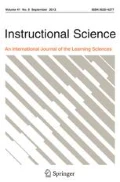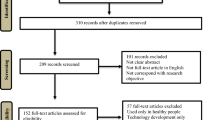Abstract
Because simulators offer the possibility of functioning as authentic representations of real-world tasks, these tools are regarded as efficient for developing expertise. The users’ experience of realism is recognised as crucial, and is often regarded as an effect of the similarity between reality and the simulator itself. In this study, it is argued that simulation as a realistic and relevant activity cannot be predesigned but emerges in the interaction between the participants, the simulator, and the context. The study draws on interaction analysis of video data from medical training. The aim is to contrast the use of two different simulators to explore the requirements needed to establish and maintain simulations as authentic representations of clinical practice. Irrespective of the realism of the simulator, glitches in the understanding of the simulation as work-related activity appear and are bridged by participants. This regularly involves an orientation to the relevant similarities with work and, simultaneously, the ruling out of irrelevant dissimilarities. In doing so, the participants rely on established professional practices to construe the situation. Moreover, the realism of the simulation is maintained through the participants’ mutual orientation to the moral order of good clinical practice and a proper simulation. It is concluded that the design of simulation activities needs to account for the possibilities of participants understanding the specific conditions of the simulation and the work practices that the simulation represents. Learning to simulate is thus something that needs further attention in its own right.


Similar content being viewed by others
Notes
Text within double brackets indicate non-verbal actions, and underlining represents emphasis.
References
Barab, S. A., Squire, K. D., & Dueber, W. (2000). A co-evolutionary model for supporting the emergence of authenticity. Educational Technology Research and Development, 48(2), 37–62.
Dieckmann, P. (Ed.). (2009). Using simulations for education, training and research, vol 3. Berlin: Pabst Science Publishers.
Dieckmann, P., Gaba, D., & Rall, M. (2007a). Deepening the theoretical foundations of patient simulation as a social practice. Simulations in Healthcare, 2(3), 183–193.
Dieckmann, P., Manser, T., Wehner, T., & Rall, M. (2007b). Reality and fiction cues in medical patient simulation: An interview study with anesthesiologists. Journal of Cognitive Engineering and Decision Making, 1(2), 148–168.
Garfinkel, H. (1967). Studies in ethnomethodology. Cambridge: Polity Press.
Garfinkel, H. (2002). Ethnomethodology’s program: Working out Durkeim’s aphorism. Lanham: Rowman and Littlefield Publishers.
Goffman, E. (1961). Encounters: Two studies in the sociology of interaction. Indianapolis: Bobbs-Merill.
Heath, C., & Luff, P. (Eds.). (2000). Technology as action. Cambridge: Cambridge University Press.
Hindmarsh, J. (2010). Peripherality, participation and communities of practice: Examining the patient in dental training. In N. Llewellyn & J. Hindmarsh (Eds.), Organisation, interaction and practice (pp. 218–240). Cambridge: Cambridge University Press.
Hindmarsh, J., & Pilnick, A. (2002). The tacit order of teamwork: Collaboration and embodied conduct in anesthesia. The Sociology Quarterly, 43(2), 139–164.
Husebø, S. E., Rystedt, H., & Friberg, F. (2011). Educating for teamwork: Nursing students’ coordination in simulated cardiac arrest situations. Journal of Advanced Nursing, 67(10), 2239–2255.
Issenberg, S. B., McGaghie, W. C., Petrusa, E. R., Gordon, D. L., & Scalese, R. J. (2005). Features and uses of high-fidelity simulations that lead to effective learning: A BEME systematic review. Medical Teacher, 27(1), 10–28.
Jacobsen, J., Lindekaer, A. L., Ostergaard, H. T., Nielsen, K., Ostergaard, D., Laub, M., et al. (2001). Management of anaphylactic shock evaluated using a full-scale anaesthesia simulator. Acta Anaesthesiologica Scandinavia, 45, 315–319.
Johnson, E. (2004). Situating simulators: The integration of simulators in medical practice. Lund: Arkiv förlag.
Johnson, E. (2007). Surgical simulators and simulated surgeons: Reconstituting medical practice and practitioners in simulations. Social Studies of Science, 37(4), 585–608.
Kalyuga, S., & Renkl, A. (2010). Expertise reversal effect and its instructional implications: Introduction to the special issue. Instructional Science, 38(3), 209–215.
Koschmann, T. (2008). Introduction to special issue on learning and work. Computer Supported Cooperative Work, 17(1), 1–3.
Lantz-Andersson, A., Linderoth, J., & Säljö, R. (2009). What’s the problem? Meaning making and learning to do mathematical word problems in the context of digital tools. Instructional Science, 37(4), 325–343.
Linell, P., & Persson Thunqvist, D. (2003). Moving in and out of framings: Activity contexts in talks with young unemployed people within a training project. Journal of Pragmatics, 35, 409–434.
Lynch, M., & Woolgar, S. (1990). Representation in scientific practice. Cambridge: MIT Press.
Petraglia, J. (1998). Reality by design: The rhetoric and technology of authenticity in education. Mahwah: Lawrence Erlbaum.
Rystedt, H. (2002). Bridging practices: Simulations in education for the healthcare professions. Göteborg: Acta Universitetis Gothoburgensis.
Rystedt, H. (2009). Simulering: Att återskapa vårdpraktik som lärandemiljöer [Simulation: Recreating caring practices as learning environments]. In J. Linderoth (Ed.), Individ, teknik och lärande [Individual, technology and learning] (pp. 44–66). Stockholm: Carlssons bokförlag.
Schegloff, E. A. (2007). Sequence organization in interaction. Cambridge: Cambridge University Press.
Sjöblom, B. (2006). To do what we usually do: An ethnomethodological investigation of intensive care simulations. Linköping: Linköping University.
Svensson, M. S. (2007). Monitoring practice and alarm technology in anaesthesiology. Health Informatics, 13(9), 9–21.
Author information
Authors and Affiliations
Corresponding author
Rights and permissions
About this article
Cite this article
Rystedt, H., Sjöblom, B. Realism, authenticity, and learning in healthcare simulations: rules of relevance and irrelevance as interactive achievements. Instr Sci 40, 785–798 (2012). https://doi.org/10.1007/s11251-012-9213-x
Received:
Accepted:
Published:
Issue Date:
DOI: https://doi.org/10.1007/s11251-012-9213-x




